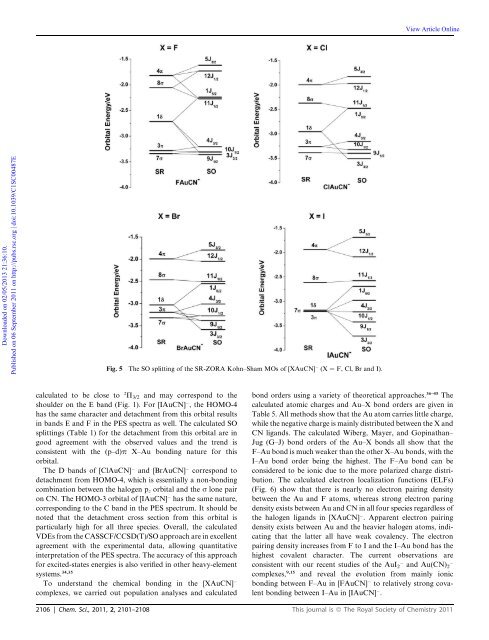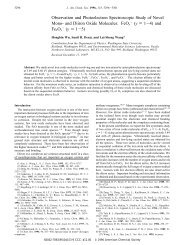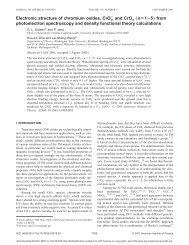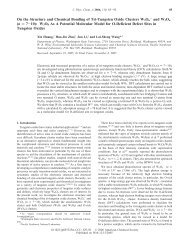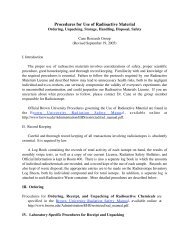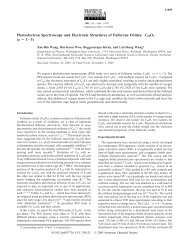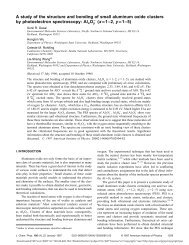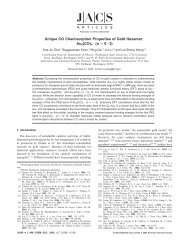View Article OnlineDownloaded on 02/05/2013 21:36:10.Published on 06 September 2011 on http://pubs.rsc.org | doi:10.1039/C1SC00487EFig. 5 The SO splitting of the SR-ZORA Kohn–Sham MOs of [XAuCN] (X ¼ F, Cl, Br and I).calcul<strong>at</strong>ed to be close to 2 P 3/2 and may correspond to theshoulder on the E band (Fig. 1). For [IAuCN] , the HOMO-4has the same character and detachment from this orbital resultsin bands E and F in the PES spectra as well. The calcul<strong>at</strong>ed SOsplittings (Table 1) for the detachment from this orbital are ingood agreement with the observed values and the trend isconsistent with the (p–d)p X–Au bonding n<strong>at</strong>ure for thisorbital.The D bands of [ClAuCN] and [BrAuCN] correspond todetachment from HOMO-4, which is essentially a non-bondingcombin<strong>at</strong>ion between the halogen p z orbital and the s lone pairon CN. The HOMO-3 orbital of [IAuCN] has the same n<strong>at</strong>ure,corresponding to the C band in the PES spectrum. It should benoted th<strong>at</strong> the detachment cross section from this orbital isparticularly high for all three species. Overall, the calcul<strong>at</strong>edVDEs from the CASSCF/CCSD(T)/SO approach are in excellentagreement with the experimental d<strong>at</strong>a, allowing quantit<strong>at</strong>iveinterpret<strong>at</strong>ion of the PES spectra. The accuracy of this approachfor excited-st<strong>at</strong>es energies is also verified in other heavy-elementsystems. 34,35To understand the chemical bonding in the [XAuCN]complexes, we carried out popul<strong>at</strong>ion analyses and calcul<strong>at</strong>edbond orders using a variety of theoretical approaches. 36–45 Thecalcul<strong>at</strong>ed <strong>at</strong>omic charges and Au–X bond orders are given inTable 5. All methods show th<strong>at</strong> the Au <strong>at</strong>om carries little charge,while the neg<strong>at</strong>ive charge is mainly distributed between the X andCN ligands. The calcul<strong>at</strong>ed Wiberg, Mayer, and Gopin<strong>at</strong>han–Jug (G–J) bond orders of the Au–X bonds all show th<strong>at</strong> theF–Au bond is much weaker than the other X–Au bonds, with theI–Au bond order being the highest. The F–Au bond can beconsidered to be ionic due to the more polarized charge distribution.The calcul<strong>at</strong>ed electron localiz<strong>at</strong>ion functions (ELFs)(Fig. 6) show th<strong>at</strong> there is nearly no electron pairing densitybetween the Au and F <strong>at</strong>oms, whereas strong electron paringdensity exists between Au and CN in all four species regardless ofthe halogen ligands in [XAuCN] . Apparent electron pairingdensity exists between Au and the heavier halogen <strong>at</strong>oms, indic<strong>at</strong>ingth<strong>at</strong> the l<strong>at</strong>ter all have weak covalency. The electronpairing density increases from F to I and the I–Au bond has thehighest covalent character. The current observ<strong>at</strong>ions areconsistent with our recent studies of the AuI 2 and Au(CN) 2complexes, 9,15 and reveal the evolution from mainly ionicbonding between F–Au in [FAuCN] to rel<strong>at</strong>ively strong covalentbonding between I–Au in [IAuCN] .2106 | Chem. Sci., 2011, 2, 2101–2108 This journal is ª The Royal Society of <strong>Chemistry</strong> 2011
View Article OnlineTable 5Theoretical <strong>at</strong>omic charges on Au and halogen <strong>at</strong>oms and the calcul<strong>at</strong>ed bond orders of X–AuNet chargeAtom Mulliken 36 Hirschfeld 39 Voronoi 40 Bader 38 MDC-q 41[FAuCN] Au 0.100 0.002 0.066 0.273 0.155F 0.626 0.461 0.498 0.699 0.525[ClAuCN] Au 0.003 0.018 0.050 0.174 0.097Cl 0.544 0.458 0.496 0.608 0.508[BrAuCN] Au 0.084 0.016 0.043 0.153 0.050Br 0.631 0.467 0.497 0.588 0.483[IAuCN] Au 0.024 0.028 0.003 0.057 0.003I 0.523 0.462 0.466 0.479 0.461Downloaded on 02/05/2013 21:36:10.Published on 06 September 2011 on http://pubs.rsc.org | doi:10.1039/C1SC00487EConclusionsWe have carried out a joint experimental and comput<strong>at</strong>ionalstudy on a series of mixed halide cyanide Au(I) complexes,[XAuCN] (X ¼ F, Cl, Br, I). Photoelectron spectra aremeasured <strong>at</strong> 206 and 157 nm for the anions with X ¼ Cl, Br, I.The well-resolved spectra are compared with rel<strong>at</strong>ivistic quantumcalcul<strong>at</strong>ions, revealing ionic bonding in F-Au and increasedcovalent bonding from Cl–Au to I–Au. The calcul<strong>at</strong>ions showth<strong>at</strong> without spin–orbit coupling all the neutral XAuCN (X ¼ F,Cl, Br, I) species have bent geometries due to Renner–Tellereffect. Differential spin–orbit coupling effects of halogen nporbitals and Au 5d orbitals are large enough to quench theRenner–Teller effect, leading to linear structures for all neutralXAuCN in their ground st<strong>at</strong>e. Calcul<strong>at</strong>ed bond orders and ELFsare all consistent with covalent bonding between Au and CN andincreased covalency between Au and the heavy halogen ligands.AcknowledgementsBond orderBond Wiberg 42 Mayer 43 G–J 44 N–M(3) 45[FAuCN] F–Au 0.337 0.545 0.366 0.840[ClAuCN] Cl–Au 0.404 0.813 0.449 0.877[BrAuCN] Br–Au 0.420 0.724 0.448 0.872[IAuCN] I–Au 0.457 0.864 0.480 0.886Fig. 6 The electron localiz<strong>at</strong>ion functions for [XAuCN] .The experimental work done <strong>at</strong> Brown University was supportedby the N<strong>at</strong>ional <strong>Science</strong> Found<strong>at</strong>ion (CHE-1049717). The theoreticalwork done <strong>at</strong> Tsinghua University was supported byNKBRSF (2011CB932400) and NSFC (20933003, 11079006,91026003) of China. The calcul<strong>at</strong>ions were done using theDeepComp 7000 Supercomputer <strong>at</strong> the Computer NetworkInform<strong>at</strong>ion Center, Chinese Academy of <strong>Science</strong>s and theShanghai Supercomputing Center.References1 G. J. Hutchings, M. Brust and H. Schmidbaur, Chem. Soc. Rev., 2008,37, 1759.2(a) D. J. Gorin, B. D. Sherry and F. D. Toste, Chem. Rev., 2008, 108,3351; (b) J. C. Y. Lin, R. T. W. Huang, C. S. Lee, A. Bh<strong>at</strong>tacharyya,W. S. Hwang and I. J. B. Lin, Chem. Rev., 2009, 109, 3561; (c)M. Pazicky, A. Loos, M. J. Ferreira, D. Serra, N. Vinokurov,F. Rominger, C. Jakel, A. S. K. Hashmi and M. Limbach,Organometallics, 2010, 29, 4448; (d) M. Alcarazo, T. Stork,A. Anoop, W. Thiel and A. Furstner, Angew. Chem., Int. Ed., 2010,49, 2542; (e) N. Marion and S. P. Nolan, Chem. Soc. Rev., 2008, 37,1776.3 H. Schmidbaur, Gold Bull., 2000, 33, 3.4 L. S. Wang, Phys. Chem. Chem. Phys., 2010, 12, 8694.5 H. Schmidbaur, S. Cronje, B. Djordjevic and O. Schuster, Chem.Phys., 2005, 311, 151.6(a) W. J. Hunks, M. C. Jennings and R. J. Puddeph<strong>at</strong>t, Inorg. Chem.,2002, 41, 4590; (b) M. J. K<strong>at</strong>z and D. B. Leznoff, J. Am. Chem. Soc.,2009, 131, 18435.7(a) P. Pyykk€o, Angew. Chem., Int. Ed., 2004, 43, 4412; (b) O. Dietz,V. M. Rayon and G. Frenking, Inorg. Chem., 2003, 42, 4977.8 T. W<strong>at</strong>ers, X. B. Wang and L. S. Wang, Coord. Chem. Rev., 2007, 251,474.9 X. B. Wang, Y. L. Wang, J. Yang, X. P. Xing, J. Li and L. S. Wang, J.Am. Chem. Soc., 2009, 131, 16368.10 P. Zaleski-Ejgierd, M. P<strong>at</strong>zschke and P. Pyykk€o, J. Chem. Phys.,2008, 128, 224303.11 X. Wu, Z. B. Qin, H. Xie, R. Cong, X. H. Wu, Z. C. Tang andH. J. Fan, J. Phys. Chem. A, 2010, 114, 12839.12 H. J. Zhai, C. Burgel, V. Bonacic-Koutecky and L. S. Wang, J. Am.Chem. Soc., 2008, 130, 9156.13 (a) B. Kiran, X. Li, H. J. Zhai and L. S. Wang, J. Chem. Phys., 2006,125, 133204; (b) H. J. Zhai, L. S. Wang, D. Y. Zubarev andA. I. Boldyrev, J. Phys. Chem. A, 2006, 110, 1689.14 D. Schroder, R. Brown, P. Schwerdtfeger, X. B. Wang, X. Yang,L. S. Wang and H. Schwarz, Angew. Chem., Int. Ed., 2003, 42, 311.15 Y. L. Wang, X. B. Wang, X. P. Xing, F. Wei, J. Li and L. S. Wang, J.Phys. Chem. A, 2010, 114, 11244.This journal is ª The Royal Society of <strong>Chemistry</strong> 2011 Chem. Sci., 2011, 2, 2101–2108 | 2107


